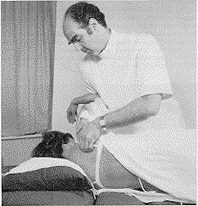Osteopathic Manipulative Treatment Techniques: Soft-tissue technique.
Source: www.healthy.net/scr/article.asp?ID=1650
One purpose of osteopathic manipulative therapy (OMT) is to restore physiological motion to areas in which there is restriction or dysfunction. By restoring or improving function in the musculo-skeletal system, it is anticipated that all connected parts will benefit, whether these are other parts of the musculo-skeletal system or areas influenced via nerve or circulatory pathways. OMT is not aimed at specific disease processes but rather at normalizing the musculo-skeletal structures with a view to benefiting overall function and thereby maximizing the body's homeostatic, self-regulating and healing activities.
There are a great variety of osteopathic manipulative methods. It is just as ridiculous to talk of manipulation, as though it is a specific entity, as it is to talk of medicine or surgery in the same terms. Just as the allopathic doctor, or surgeon, has a wide range of choice regarding medication or surgical procedure, so does the osteopathic practitioner have a wide range of choices regarding techniques and methods of manipulation.
Among the aims of manipulation are the restoration to normal of the supporting tissues such as muscle, ligaments, fascia etc. Then there is the normalization of movement and articulation, there is the use of reflex, mechanical, influence on the body as a whole. Techniques can, roughly speaking, be divided into three groups:

Shows a soft tissue stretching technique in which the shoulder girdle muscles are lifted and stretched. It also simultaneously allows articulation of the shoulder joint.
Soft-tissue techniques.
These are varied and involve any method that is directed towards tissue other than bone. Frequently soft-tissue techniques are used diagnostically, as well as therapeutically. Soft-tissue techniques may involve stretching movements across or along the lines of the muscular fibres and deep pressure techniques, as well as stretching and separation of muscle and other soft-tissue fibres, especially where muscles originate or insert into bony structures. Much soft-tissue manipulation involves working on fascia or connective tissues.
These methods usually precede manipulation of the bony structures but can frequently achieve mobilization and normalization of joint structures on their own. This can result from the improvement of rigid or tense tissues, allowing a previously restricted joint to achieve a free range of motion.
A uniquely British contribution to this end was developed by the late Stanley Lief D.O., and it is in the use of this and other soft-tissue methods that attention is usually paid to the reflex areas that might influence the patient's condition. These might range from simple trigger points to more complex reflexes, involving internal function (Chapman's reflexes etc.). With soft-tissue techniques, diagnosis and treatment are often simultaneous. As the practitioner is palpating and assessing the tissue for signs of dysfunction, so is he treating and attempting to normalize what he finds.
Coming January 2006: OMT technique videos online!
0 Comments:
Post a Comment
<< Home